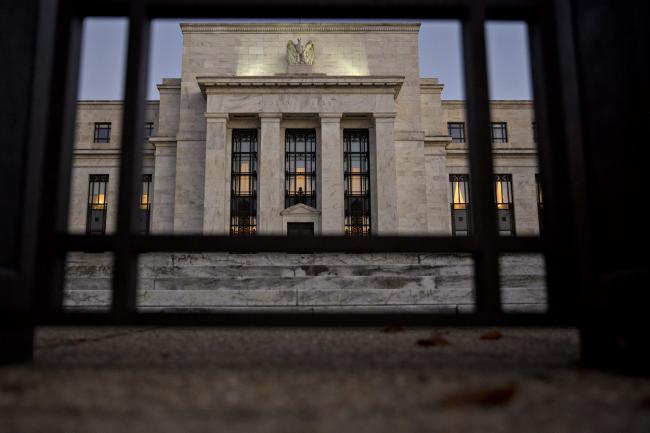 © Bloomberg. The Marriner S. Eccles Federal Reserve building stands in Washington, D.C., U.S., on Friday, Nov. 18, 2016. Photographer: Andrew Harrer/Bloomberg
© Bloomberg. The Marriner S. Eccles Federal Reserve building stands in Washington, D.C., U.S., on Friday, Nov. 18, 2016. Photographer: Andrew Harrer/Bloomberg(Bloomberg) — Fixed-income traders are telling the Federal Reserve that it might end up making a big policy mistake.
And it’s not just rising interest rates they’re talking about.
A more pressing concern has to do with the Fed’s crisis-era bond investments. Since October of last year, the central bank has been steadily reducing its holdings of Treasuries and mortgage-backed bonds. But as the unwind has picked up, unexpected knock-on effects are emerging in overnight lending markets, where demand for short-term cash has been on the rise.
Fed officials, who are meeting in Washington to discuss monetary policy, have pooh-poohed the idea that they are to blame and point to various technical factors. Yet a growing number on Wall Street aren’t buying it. The most vocal critics contend that if the Fed doesn’t slow or stop its unwind, it could end up draining too much money from the banking system, cause market volatility to surge and undermine its ability to control its rate-setting policy.
“The Fed is in denial,” said Priya Misra, the head of global interest-rate strategy at TD Securities. “If the Fed continues to let its balance-sheet runoff continue, then reserves will begin to become scarce.”
The Fed hasn’t explicitly said when it would stop shrinking its balance sheet. TD’s Misra estimates it will by December 2019, though she wouldn’t be surprised if the runoff ended sooner. If the Fed maintains its current pace through the end of next year, its assets would fall to about $3.7 trillion from $4.1 trillion today (and a high of $4.5 trillion). That’d still be more than the $900 billion it held pre-crisis.
So it’s curious to think that at current balance-sheet levels, the U.S. banking system could be facing a problem of not having enough cash. And the mechanics of what Misra and others describe aren’t easy to understand.
But to oversimplify, the argument essentially goes like this: The Fed’s bond buying, or quantitative easing, pumped trillions of dollars into the banking system to support the economy after the financial crisis. (The Fed bought bonds from banks and paid for them by crediting their reserves.) Now, with the economy on solid ground, that money is effectively being sucked out as the Fed reverses that policy. Currently, the Fed is paring its bond holdings by a maximum of $50 billion a month.
The trouble is, post-crisis rules enacted to curb risk-taking, like Dodd-Frank and Basel III, have prompted banks to use much of those same reserves — upwards of $2 trillion worth — to meet the more stringent requirements. It’s those forces that are, in effect, creating the scarcity of reserves that has banks — mainly the smaller ones at this point — scrambling for short-term dollar funding. Since the Fed started shrinking its assets, reserves have fallen by more than a half-trillion dollars, according to Fed data from Barclays (LON:).
“The current backdrop is one that is dominated by the regulatory landscape,” said Jonathan Cohn, the head of interest-rate trading strategy at Credit Suisse (SIX:). He estimates excess high-quality liquid assets (which include reserves) at the eight U.S. globally systemically important banks have fallen by more than 15 percent since the Fed began its unwind. “Banks are in a decent position right now, but over time this will begin to weigh” on them.
One of the clearest signs of that stress is in the market for fed funds, which is where banks lend to each other on an overnight basis.
What’s key is that the effective rate for these loans is what the Fed targets when it sets interest rates. The central bank establishes a target range, currently 2 percent to 2.25 percent, and uses two policy tools — interest on excess reserves, or IOER, near the upper end, and the reverse repo rate, or RRP, on the lower end — to keep the effective rate within that band.
In June, the Fed tweaked IOER so that it is now slightly below the upper target. (Before, IOER and the upper band were the one and the same.) The change came as domestic banks doubled their share of daily demand for fed funds in the second quarter from the start of the year, according to Bank of America (NYSE:).
Since the Fed began paring its bond holdings though, the effective rate has started to creep higher. Last month, it even bumped up against IOER for the first time since 2009. Some link the drift higher to the Fed’s unwind.
The Fed disputes that characterization. Minutes from the Fed’s September meeting showed that officials saw new T-bill sales, rising yields and higher repo rates as the catalyst for the recent upswing. Simon Potter, head of the markets group at the New York Fed, was more emphatic, saying the rise in the fed funds rate “is not a sufficient condition for reserve scarcity.”
Nevertheless, analysts predict another tweak to IOER either this month or next, which is when traders project the Fed will raise its target rate.
Michael Cloherty, the head of U.S. interest rate strategy at RBC Capital Markets, is worried. He says the biggest risk is the Fed turns a blind eye to the pressures on bank reserves and triggers huge swings in short-term rates with its balance-sheet runoff.
“At some point, all of the reserves outstanding will be locked up by all the people who need it” to meet all the regulatory mandates, which may lead to a “scramble” for short-term cash, he said. “If the Fed keeps shrinking its balance sheet until it sees signs of stress, the question will be, ‘How ugly is that stress?’ I think it will be quite ugly.”
Source: Investing.com





























